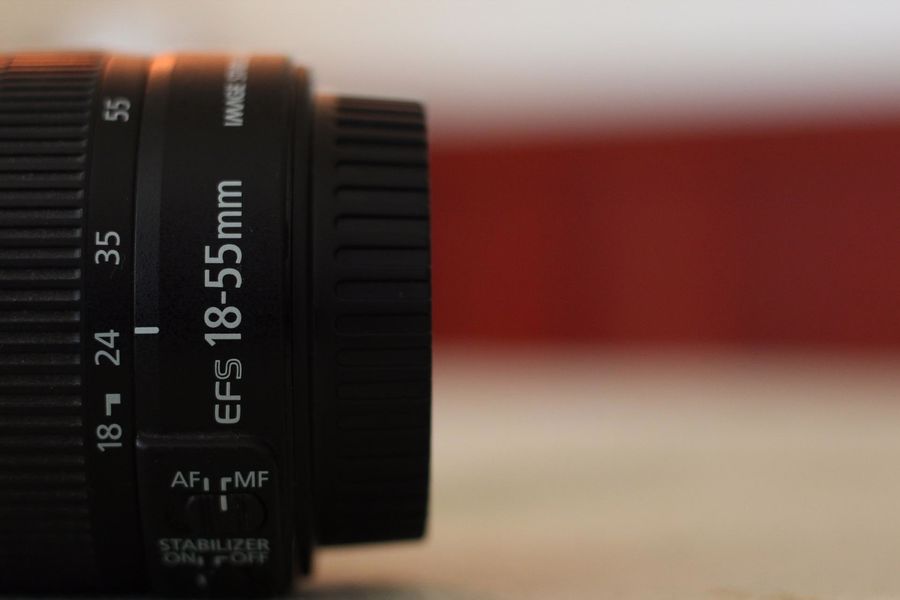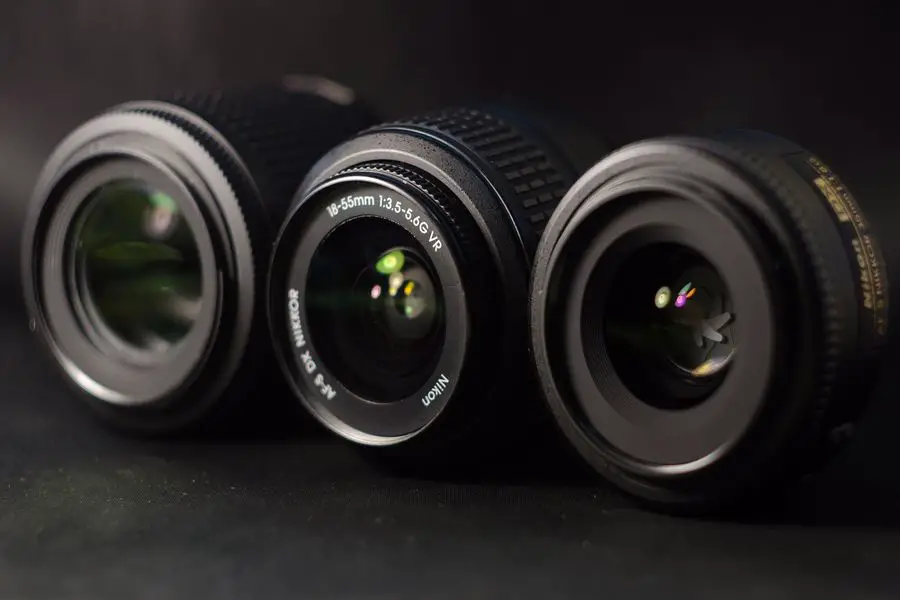As an Amazon Associate we earn from qualifying purchases.
A staple lens of a typical DSLR is the standard 18-55mm. I’ve found many beginners who start with this lens to be confused by what is the difference between 18-55mm and 55-200mm. The fact is, both lenses will provide you with excellent results in every scenario.
Contents
What Is the Difference Between 18-55mm and 55-200mm?
The 18-55 mm crop sensor lens has a variety of focal lengths and can be zoomed in to get closer to your subject. However, the 55-200 mm lens produces far better results and has a super zoom range that allows you to focus on distant objects.

For long-distance photos, the 55-200mm lens is preferable. For example, if you want to shoot a bird perched on a branch, you’ll need a larger zoom since you won’t be able to get close to it. Shooting sports like football or hockey requires getting closer to the subject than is possible in real life.
18-55mm
The 18-55mm lens is the best one for everyday use. It’s a great walk-around lens that you can use for everything from scenery to children’s portraits. It also works well in low-light situations due to its wide aperture.
The 18-55mm lens field is comparable to 27-83mm in 35mm film format. It’s a small, lightweight zoom with a maximum aperture of f/3.5-5.6 and a minimum aperture of f/22-38. The lens is made up of nine components organized into eight groups. It features a circular aperture diaphragm with seven blades and 52mm filters.
- Manufacturer Model Number: F XF18-55mm F2.8-4 R
- Size: φ2.6 x H 2.8 inches (65.0 x 70.4 mm)
- Weight: Approx. 10.6 oz (310 g) (not including lens cap and hood)
A zoom lens having a changeable maximum aperture is known as a variable-aperture lens. The famous Canon 18-55mm kit lens, for example, has a variable maximum aperture of f/3.5-5.6, meaning that when you zoom in to 55mm, the maximum aperture varies from f/3.5 to f/5.6.
Advantages of an 18-55mm Lens
- Versatility: An 18-55mm lens is considered medium-range, allowing you to take close-up shots as well as wide-angle shots. This type of lens is often referred to as a “walk-around” lens because it is ideal for all photography occasions and styles.
- It’s light and small: The 18-55mm is the smallest lens in most camera kits, making it easy to carry around, especially when paired with a small mirrorless camera. It’s perfectly suited to travel and street photography, where you want to be as discreet as possible.
- It has image stabilization: Almost all 18-55 lenses have built-in image stabilization (some older models do not). It allows you to use slower shutter speeds without any risk of blur from the camera shake. It can be instrumental in low light conditions.
- Affordable: Because this type of lens is so versatile, you can easily use it for nearly any kind of photography or video work. However, the lens is generally more affordable than other options in the same range (which can cost hundreds or even thousands).
- Easy to use: Even if you don’t have much experience with photography, this type of lens will help you get great results right away!

55-200mm
Although many lenses are available for DSLR cameras, one stands out as the most adaptable in terms of range and capability. The 55-200mm lens is a conventional zoom lens with a focal length range of 55 to 200mm. It means you may use it for anything from wide-angle photos to close-up portraits.
- Focal Length & Maximum Aperture: 55-200mm f/4.5-6.3
- Lens Construction: 17 elements in 11 groups
- Diagonal Angle of View: 2750'-750'
The 55-200mm lens’s quality has substantially increased throughout the years. Suspension systems and internal focusing mechanisms make them incredibly simple to handle and maneuver in today’s versions. The 55-200mm lens is also one of the lightest on the market, making it ideal for travel photography.
It has a zoom range of 55-200mm, which is more than most people would want. This lens is not designed for extreme sports or wildlife photography, but it’s a perfect size for travel, portraiture, and daily usage.
Advantages of a 55-200mm
- The primary advantages of the 55-200mm lens over the 18-55mm kit lens are its more extended focal length range (which is equivalent to 82.5-300mm on a full-frame camera) and its smaller size and weight.
- The 55-200mm offers a much more zoomed-in field of view than the 18-55mm, and also provides a slightly larger aperture at 200mm than the 18-55mm does at 55mm (f/5.6 vs. f/5.8).
- The other advantage is size and weight. A 55-200mm lens will be smaller and lighter than an 18-200mm lens. It can be vital if you like to hike or travel with your camera.
Which Is Better Between the 18-55mm and 55-200mm and Why?
Three main factors distinguish these two lenses from one another: range, aperture, and size. The 18-55mm is better for wide-angle shots, and the 55-200mm is better for getting close-up shots from far away.
Aperture
You will often see lenses described as having “fast” or “slow” maximum aperture settings. The 18-55mm kit lens has a maximum aperture of f/3.5 when zoomed to its most expansive location (18mm) and slows down to f/5.6 at 55mm.
In contrast, the 55-200mm has a maximum aperture of f/4 at 55mm and slows down to f/5.6 at 200mm. The larger the maximum aperture on your lens, the better you can separate your subject from its background, which creates a pleasing effect called bokeh (named after Japanese photographer Bokeh Fujii).

Focal Length
The 18-55mm lens has a focal length of 18 to 55mm that can zoom from wide-angle to short telephoto, which is 28mm wide on a crop sensor camera and 35mm wide on a full-frame camera. This kind of lens is suitable for landscapes, architecture, and group photos in which you need to have a more comprehensive view.
The 55-200mm lens has a range of 55 to 200mm that zooms from medium telephoto to super-telephoto, which is 82mm on a crop sensor camera and 105mm on a full-frame one. This kind of lens is suitable for portraits, wildlife, and sports in which you need to zoom in on the subjects.
Image Quality
Another critical difference is image quality. Telephoto zoom lenses can never achieve the same sharpness as high-quality prime lenses like the 18-55mm. In most situations, even the best 55-200mm lens won’t match it for image quality.
However, not all telephoto zooms are created equal either. As with any other lens category, you have cheap models that perform poorly and expensive models that perform better (but still don’t reach exceptional levels).
Frequently Asked Questions
What Is a 55-200mm Lens Used For?
The 55-200mm lens is most often used for sports, wildlife, and candid photography. The longer focal length allows you to keep your distance from the subject while capturing the action. Although it doesn’t have a wide aperture like some telephoto lenses, the 55-200mm VR is light and compact, so it’s easier to carry with you all day.
What Is the 18mm 55mm Lens Good For?
The 18–55 mm lens is a zoom lens with a wide-angle of view, allowing you to include more in the photo. The short telephoto position makes portraits or other shots valuable to compress perspective and make background objects seem more significant.
How Much Zoom Does a 55-200mm Lens Have?
A zoom ratio of about 3.6x is achieved using a 55-200mm lens. The most significant focal length is approximately 3.6 times the lowest focal length.
Conclusion
The most glaring difference between these two lenses is the aperture. The 18-55 offers an f/3.5-f/5.6, whereas the 55-200 has an f/4-f/5.6. Both lenses have image stabilization and a minimum focus distance of 12-30, but both have a maximum magnification of .21x, which is not a lot of zooming in and out.


